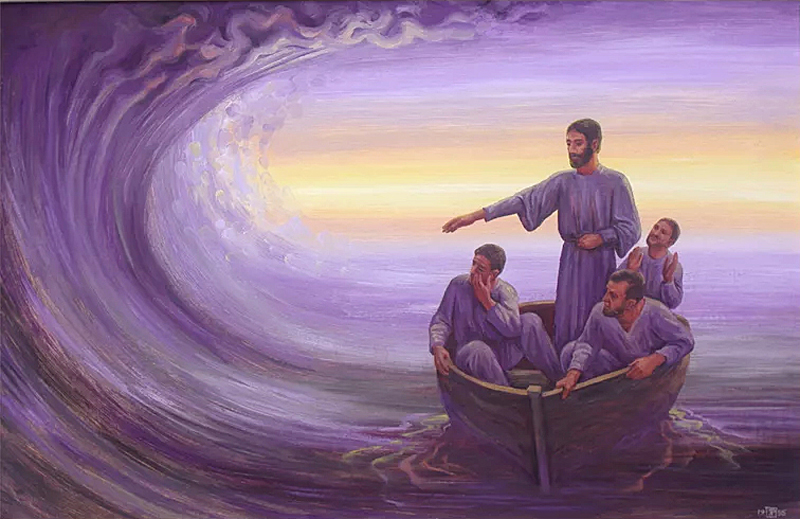And leaving the crowd behind, they took him with them in the boat....
A great windstorm arose, and the waves beat into the boat, so that the boat was already being swamped.
But he was in the stern, asleep on the cushion; and they woke him up and said to him,
"Teacher, do you not care that we are perishing?"
He woke up and rebuked the wind, and said to the sea, "Peace! Be still!"
Then the wind ceased, and there was a dead calm.
He said to them, "Why are you afraid? Have you still no faith?"
And they were filled with great awe and said to one another,
"Who then is this, that even the wind and the sea obey him?"
- Mark 4:35-41

Calming of the Storm
Peter Koenig, 1995
My dear friends,
At first glance, the story of Jesus calming a storm on the Sea of Galilee may seem to be about a miraculous occurrence long ago and far away. However, upon deeper reflection, its symbolism can be understood to apply to our own spiritual development, here and now.
The symbolism of the boat is deeply entrenched in many spiritual traditions, including Mahayana Buddhism. The boat is often seen as a vessel that aids in crossing from the shore of ignorance, suffering, and samsara (the cycle of rebirth) to the shore of enlightenment and peace (nirvana).
When Jesus says, "Let us go over to the other side," it can be interpreted in this light as an invitation to embark on a spiritual journey from fear to faith, from turmoil to peace, from ignorance to awakening. The boat, carrying Jesus and his disciples amidst the storm, can be seen as the vessel of teachings — both Jesus' teachings and the larger corpus of wisdom teachings — that help us navigate the sea of life with its challenges and uncertainties.
The sea of life is not always calm; it can be turbulent, full of storms and unexpected waves - the difficulties, trials and tribulations that we face in life - whether external or internal, the results of our own deluded thinking and afflictive emotions. When the storm hits, the disciples panic. They are lost, unsure of what to do, and fear they might drown. How often do we find ourselves in a similar state? When faced with problems, do we not allow fear and anxiety to take control of our minds?
In the midst of this chaos, there is Jesus, sleeping peacefully in the stern. Even in the midst of turmoil, this peace is undisturbed. But it must be awakened, it must be invoked.
The disciples wake Jesus, their plea an invocation of higher wisdom when in distress. And Jesus, once awakened, calms the storm. He does not remove the disciples from the storm or take the storm away from them; instead, he brings peace into the storm, tranquility into the chaos. This is how we can bring peace into our lives, not by avoiding or resisting our problems, but by facing them with a calm and peaceful mind.
Jesus' question, "Why are you so afraid? Do you still have no faith?" invites us to examine our own lives. What indeed is the faith that conquers fear?
but perfect love casts out fear;
for fear has to do with punishment,
and whoever fears has not reached perfection in love.
- 1 John 4:18
From the perspective of Buddhism, this "perfect love" can be equated with Bodhichitta, the awakened mind that is motivated by great compassion for all sentient beings. It is the mind that strives toward awakening, enlightenment, and an end to suffering, not just for oneself but for all.
In the story of Jesus calming the storm, when the disciples wake Jesus out of fear, his response is not of panic but of peace. This peace, which he brings to the storm, is a manifestation of "perfect love," a love that casts out fear. His awakened mind, filled with love and compassion, sees not a threatening storm, but an opportunity for teaching, for awakening, for demonstrating the power of faith, peace, and love.
Similarly, the Buddha, upon his enlightenment under the Bodhi tree, did not keep the wisdom and peace he had attained to himself. Out of great love and compassion, he chose to teach, to help others awaken their potential, their Buddha-nature, to alleviate their suffering.
The disciples' fear is a manifestation of their unrealized potential. They have not yet been "perfected in love": their potential for Bodhichitta has not yet been fully awakened. But through the compassionate teaching of Jesus, they have a glimpse of what is possible. They see the power of perfect love to bring peace to even the most chaotic of storms. Their question, "Who is this? Even the wind and the waves obey him!" reflects their newfound awe and respect. They have discovered, in their teacher, an embodiment of peace and strength they did not previously comprehend.
This story serves as a reminder for all of us. We all have within us the potential for Bodhichitta, for perfect love. Through diligent practice, through cultivating wisdom and compassion, we can awaken this potential, we can calm our inner storms, and we can bring peace to the world around us. This is the path to spiritual growth and fulfillment.